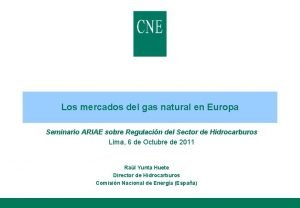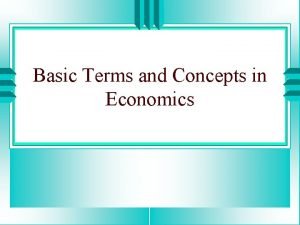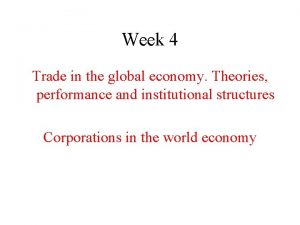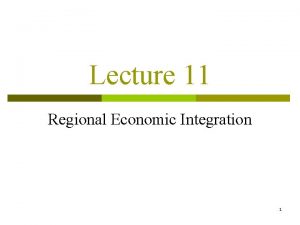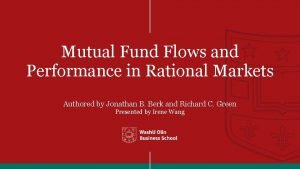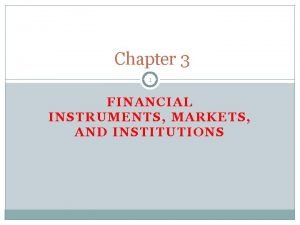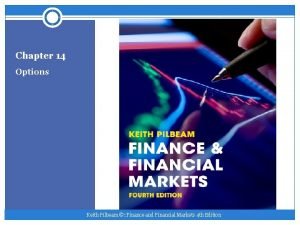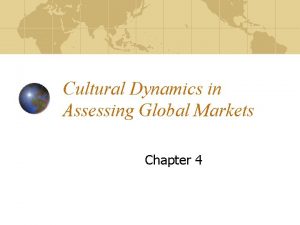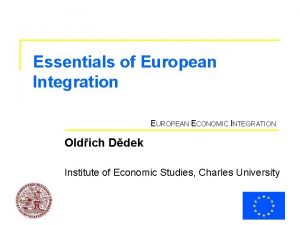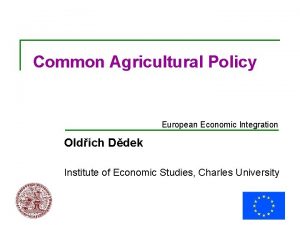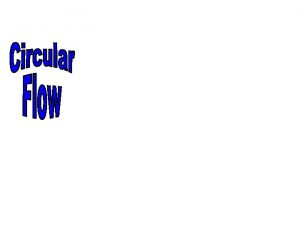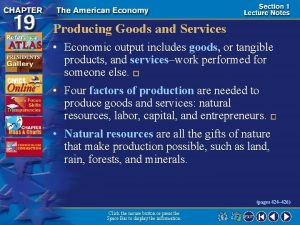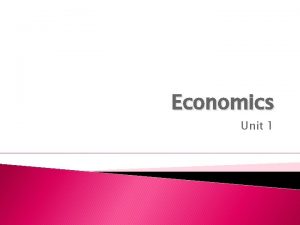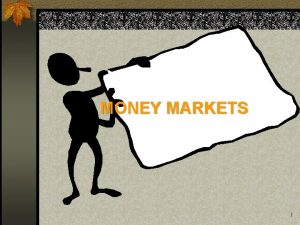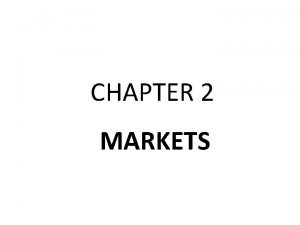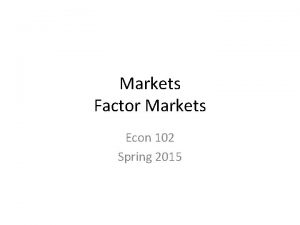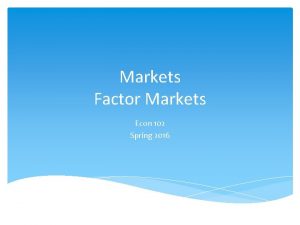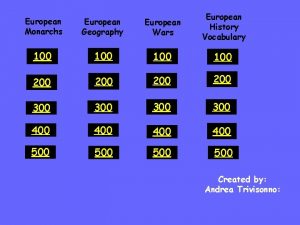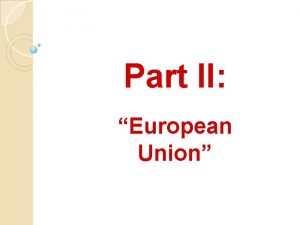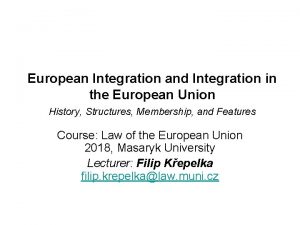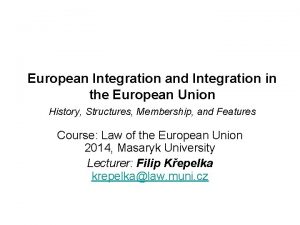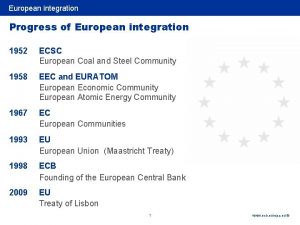Integration of Goods Markets EUROPEAN ECONOMIC INTEGRATION Oldich


























- Slides: 26

Integration of Goods Markets EUROPEAN ECONOMIC INTEGRATION Oldřich Dědek Institute of Economic Studies, Charles University

Arguments in favour of free trade n Ricardian theory of comparative advantage q n Heckscher-Ohlin theorem q n A country should specialise on a commodity whose production is intensive of the factor in which the country is relatively abundant (source of comparative advantage) Intra-industry trade q n A country should specialise in the production and export of the good where its comparative advantage is greater and import the product where its comparative advantage is lower (win-win game) Countries can benefit from trade in close substitutes (i. e. in similar but slightly different products) Economies of scale q A free trade allows firms to operate on a larger and more efficient scale and allows to capture learning effects 2

Ricardian theory of comparative advantage Note: utility for consumer = price of good = unit labour costs (according to labour theory) Units: wine in gallons, cloth in yards, time in hours 3

Heckscher-Ohlin theorem Closed economies Open economies X 1 A Ex. A 1 Im. B 1 Im. A 2 B X 2 n n n Ex. B 2 X 2 Explanation of the source of comparative advantage: pattern of different endowments of factors of productions Trade along price line improves welfare in both economies Trade acts as a substitute for the international mobility of factors (liberalization of trade will bring about the equalization of relative and absolute returns to factors of production) 4

New trade theories n 5

Arguments in favour of protection Infant industry n q q q Second best n q q n If conditions of perfect competition are violated in some part of the world it need not be optimal for others to stick to the rules of perfect competition; protection may be welfare improving A move to free trade should be decided case by case Optimal tariff q q n A new industry is not able to compete with established firms and therefore needs time to acquire experience or to reach a sufficient size to benefit from economies of scale Problems with practical implementation: ensuring competitiveness at free trade world prices, eventual benefits should exceed the cost of protection Abuse for protectionism: politicized selection of protected industries, pressure to continue with protection, protection of non-viable industries A tariff introduced on a widely used good reduces consumption causing the world price to fall, foreign producers bear part of the cost of tariff (John Stuart Mill) Critique: retaliation on the part of other countries Strategic trade theory q q Countries can gain comparative advantage irrespective of the initial endowments of factors of production Comparative advantage can be created by an active trade policy and strategies to promote investment (promotion of high-tech industries, research and development, investment in infrastructure, etc. ) 6

Tariff and non-tariff trade barriers n n n Import tariff is a tax or duty levied on imported goods (ad valorem, specific, compound) Quota is a quantitative restriction imposed on imports of a particular product or on imports from a particular country Voluntary export restraint (VER) is restriction imposed unilaterally by the exporting country, usually to avoid hostile measures by the importing country Dumping occurs when the price charged by an exporter to a foreign market is lower than the domestic price Export subsidies take various forms of assistance to exporters (direct payments, tax brakes, low-interest or subsidised loans, etc. ) Technical barriers to trade (TBT) are specified modifications of products that make entry to national markets possible (safety regulation, health and environmental requirements, labelling, customs formalities, etc. ) 7

Consumer and producer surplus (rent) Demand curve (D) Supply curve (S) P P S a c b D d Q Total utility = a + b Total expenditure = b Consumer surplus = a Q Total revenue = c + d Total cost = d Producer surplus = c 8

Lower price (ΔT) Measuring benefits of tariff reduction Price elasticity of imports Tra de cre atio n Increase of imports (ΔM) Numerical example: 9

Import demand export supply D (demand) S (supply) MD (import demand) XS (export supply) P P S P 1 a P 0 b XS c d MD D Q n Welfare effects of price increase from P 0 to P 1 q q q n M, X Decline in consumer surplus = - a - b Increase in producer surplus = a Total loss = - b = - (c + d) Decomposition of welfare effect into price and quantity effects q q Price effect = c (higher expenditures on imported goods) Quantity effect = d (loss due to lower imports) 10

Free trade equilibrium Foreign economy (F) Home economy (H) XSH P P XSF PFT MDH MDF XFT n MDF MFT Free trade equilibrium price PFT makes domestic import demand MDH equal to foreign export supply XSF 11

Impact of tariff – price and quantity effects Foreign economy (F) XSF n XSF T MDH XT n XSF+T PT PFT PX Home economy (H) XFT MT MFT Tariff T (specific) shifts foreign export supply by same amount Properties of new equilibrium (after levying T) q Home economy lowers imports (from MFT to MT) q Home consumers pay higher price PT and cut consumption q Home producers get higher price PT and raise production q Foreign importers get lower price PX and cut imports 12

Impact of tariff – welfare effects Foreign economy (F) XSF+T PT PFT PX n n n Home economy (H) XSF T a b XSF+T c a d b XSF MDH XFT XT MT MFT Welfare decline in foreign economy = - a - b Decline of private welfare in home economy = - c - d (consumers’ loss exceeds producers’ gain) Tariff revenue for home government = a + c (a is extra tax on foreigners, c is extra tax on home residents) Ambiguous impact on total welfare in home economy = a - d = (- c - d) + (a + c) Drop in global welfare = - b - d = (- a - b) + (a - d ) 13

Import quota Price and quantity Welfare effects XSF + TE PQ PFT XSF TE n n XSF d b MDH MQ n T c a MFT MQ MFT Holder of import licence is recipient of a rent a + c Tariff equivalent of quota is hypothetical tariff with same outcome on imported quantity as given quota Import quota offers a better guarantee that quantity of imports will be limited 14

Voluntary export restraint Price and quantity Welfare effects XSNT PVER PFT XSF T n n c a d b XSF MDH MVER n T MFT MVER MFT VERs are bilaterally negotiated agreements (operated through quotas or minimum export prices) VER is equivalent to import quota The recipient of rent a + c is the importer, which may make him more tolerant to this trade restriction 15

Non-discriminatory tariff – prices and quantities Rest (R) Partner (P) Home economy (H) XSNT P PFT n n XSFT T XNT n XSP XSR PNT MDH XFT XNT XFT MNT MFT Total import supply function is derived by horizontal addition of individual foreign import supplies Non-discriminatory tariff is levied on all importers at same rate Non-discriminatory liberalisation means removing tariffs equally for all importers 16

Viner’s effects n n n Trade creation arises when domestic production is replaced by cheaper imports from partner country Trade diversion arises when low-cost imports from suppliers in the third countries are replaced by more expensive imports from a partner country The two effects were introduced by Canadian economist Jacob Viner in 1950 Production costs Tariff 100 % Tariff 50 % A 60 60 60 B 50 100 50 C 35 70 52, 5 Non-discriminatory elimination of 100 % tariff trade creation (imports from C at a price 35) Creation of customs union between A and B with 50 % common tariff trade creation (imports from B at price 50) trade diversion (termination of imports from C at potential price 35) 17

Discriminatory tariff – prices and quantities Rest (R) P PNT PDT PFT n n Home economy (H) XSNT P XSR XSDT XSFT XSP T XDT XNT XFT n Partner (P) MDH XNT XFT XDT MNT MDT MFT Discriminatory (preferential) liberalisation lowers prices in home economy (removal of tariffs on part of imports), lowers prices in partner economy (total removal of tariffs) and possibly lowers prices in rest of world (pressure from lower prices in CU) Higher imports into home economy (trade creation) Higher exports from partner economy and lower exports from rest of world (trade diversion) 18

Discriminatory tariff – welfare effects Rest (R) PNT PDT Partner (P) XSR T Home economy (H) f XSP g h XDT XNT n n n XDT XR, DT c MDH MNT MDT Lower welfare in rest of world (negative price and quantity effect) Higher welfare in partner economy (positive price and quantity effect) Ambiguous impact on home economy (Viner ambiguity) q q n XNT d a e b Higher private welfare = c + e + f Loss of non-discriminatory tariff revenue = b + d + e + f Income from discriminatory tariff = a + d Total change in welfare = (c + e + f ) – (b + d + e + f) + (a + d) = a – b + c Gain for partner (g) and loss for rest of world (h) 19

Formation of customs union – plans and n Removal of internal tariffs reality q q n Removal of internal quotas q q q n Plan: three stages each spanning 4 years (1958 -61, 1962 -65, 1966 -69) with tolerated delay of 3 years Reality: completion of tariff elimination 1. 5 years ahead (January 1962 40 %, January 1966 80 %, July 1968 100 %) Favourable surrounding macroeconomic conditions (Golden Age) soothing political and economic costs of restructuring Transition to the second stage was associated with the replacement of unanimity by qualified majority voting (blocked by France) Transformation of bilateral quotas into global ones (available to all), piecemeal reduction and then complete abolition Objectives achieved as early as 1961 National quotas against third countries were addressed later in SEA Common external tariff q q CET was set at arithmetic average of tariffs of Six valid before creation of EEC FR, IT reduction, Benelux increase, DE preservation of current level (setting new tariff level is more difficult than abolition of tariffs) Tariff revenue became key financial source for European budget (now approx. 10% of total revenues) Complicating element: preferential trade arrangement with former colonies Piecemeal reduction in tariffs was also the result of GATT/WTO negotiation rounds 20

CU versus FTA n Trade deflection in FTA q q q n Channelling of imports into FTA through a member with lowest tariffs and subsequent re-export to other FTA members in tarifffree regime all tariff revenue is collected by lowest tariff country Standard defence: rules of origin (only goods produced in FTA members can enjoy tariff-free regime) High administrative costs of the regulation (difficult to comply in case of complex products with a wide network of international suppliers) arbitrary limits for „domestic content“ (e. g. 50 %) Easy misuse for protectionist practices Customs union with CET eliminates trade deflection but at cost of a deeper integration some countries may not be willing to accept Supranational features of CU q q q Pressure to centralise decision-making (joint position in GATT/WTO negotiations, conclusion of trade treaties, joint antidumping policy, fair distribution of tariff revenue) Without supranational authority CU becomes clumsy body Well functioning CU thus presupposes some political integration 21

CU versus GATT n CU represents codified form of discriminatory liberalisation subject to certain conditions (to minimise trade diversion) q q q n Removal of tariff for large part of mutual trade (approx. 80%) Transition period must be reasonably short (approx. 10 years) CET is not allowed to lead to higher average tariff protection after CU is established Arguments in favour of CU q q q CU may be seen as legitimate process of creation of larger economic units with common policies and stronger negotiating powers against rest of world Dynamic effects (decline in tariff protection in GATT/WTO negotiations, inclusion of other countries, participation of nonmembers in CU growth effects) Functioning CU serves as springboard to higher forms of integration 22

Technical barriers to trade (TBT) n n n Many of technical specifications serve legitimate goals of public policy (protecting the environment, human health, safety, etc. ) Product standards have an important influence on market access and the export performance of businesses They can be costly and burdensome by design or restrict international trade Widespread form of protectionism applied after tariff barriers were removed (1970 s suffered from stagflation) Depressing impression from functioning of common market, in contrast with growing industrial might of USA and Japan (“euro-sclerosis”, “uncommon market”) 23

High publicity cases of TBT n Germany‘s beer purity law q q q n Italy‘s pasta purity law q n q q Rule of Belgian authorities that products such as Scotch whisky must not be sold without a British certificate of authenticity Trader Dassonville that re-exported the whisky from France to Belgium made his own certificate of authenticity and was accused of forging The ECJ ruled that the measure had equivalent effect of restricting trade Cassis de Dijon (1979) q q q n Ban on imports under the law requiring that all pasta be made with durum wheat Dassonville (1974) q n Regulation prohibiting beers containing chemical catalysts and preservatives Suitable for beers with a short lifespan and produced in small volumes Unsuitable for imports of large scale beer production with long-distance supply and storage German ban on importing fruit liqueurs with alcohol content of less than 25 % Risks for public health (low alcohol drinks may strengthen the tolerance of alcohol among the young) and consumer protection (consumers may feel cheated because they expect a certain amount of alcohol) The case led the ECJ to formulate the principle of mutual recognition Poitiers case (1982) q q Decree of French government that all packages with Japanese VCRs should undergo inspection in the town of Poitiers whether the manual in French is accompanied Poitiers was far from all main ports of entry 24

TBT – graphical representation Price and quantity Welfare effects XSF + T PTBT PFT XSF T n a b MDH MTBT n XSF MFT MTBT MFT TBT are so-called friction barriers which do not create rents (no lost tariff income due to TBT liberalisation) Removing TBT increases welfare of home economy (positive price effect a, positive quantity effect b) 25

EU regulatory regimes for TBT n Harmonization of standards (old approach) q q q n Principle of mutual recognition q q n Detailed technical regulation for individual product or product groups implemented through directives Time-consuming and clumsy procedures for removing existing TBT in face of flourishing new ones (average time for new directive 8 -10 years) Limited progress under condition of unanimous decision-making All goods lawfully manufactured and marketed in one MS should be accepted also in other MS Baseline idea: MS have equivalent objectives in safety, environmental and consumer protection irrespective of details between national rules Minimum standards (new approach) q q q EU directive defines only the essential requirements that goods must meet when they are placed on the market Task of drawing up the corresponding technical specifications is entrusted to the standardisation bodies Products manufactured in conformity with harmonized standards are allowed to enter the markets of MS 26
 Convenience goods shopping goods specialty goods
Convenience goods shopping goods specialty goods Unique features of digital markets
Unique features of digital markets Digital goods ecommerce
Digital goods ecommerce E-commerce: digital markets, digital goods
E-commerce: digital markets, digital goods Heren european spot gas markets
Heren european spot gas markets Positive consumption externality
Positive consumption externality Public goods dan private goods adalah
Public goods dan private goods adalah Progressive tax definition
Progressive tax definition Monoperiod goods
Monoperiod goods European exploration economic reasons
European exploration economic reasons Economic growth vs economic development
Economic growth vs economic development Difference between economic growth and economic development
Difference between economic growth and economic development Economic systems lesson 2 our economic choices
Economic systems lesson 2 our economic choices Regionalization and globalization venn diagram
Regionalization and globalization venn diagram Types of economic integration pdf
Types of economic integration pdf Forward integration and backward integration
Forward integration and backward integration Forward backward integration
Forward backward integration Simultaneous integration and sequential integration
Simultaneous integration and sequential integration Nomura connecting markets east & west
Nomura connecting markets east & west Mutual fund flows and performance in rational markets
Mutual fund flows and performance in rational markets Financial markets instruments and institutions
Financial markets instruments and institutions Market coverage strategy
Market coverage strategy Pilbeam k. finance and financial markets
Pilbeam k. finance and financial markets Mechanics of futures market
Mechanics of futures market Cultural dynamics in assessing global markets
Cultural dynamics in assessing global markets Why study financial markets
Why study financial markets The most basic determinant of a person's wants and behavior
The most basic determinant of a person's wants and behavior




